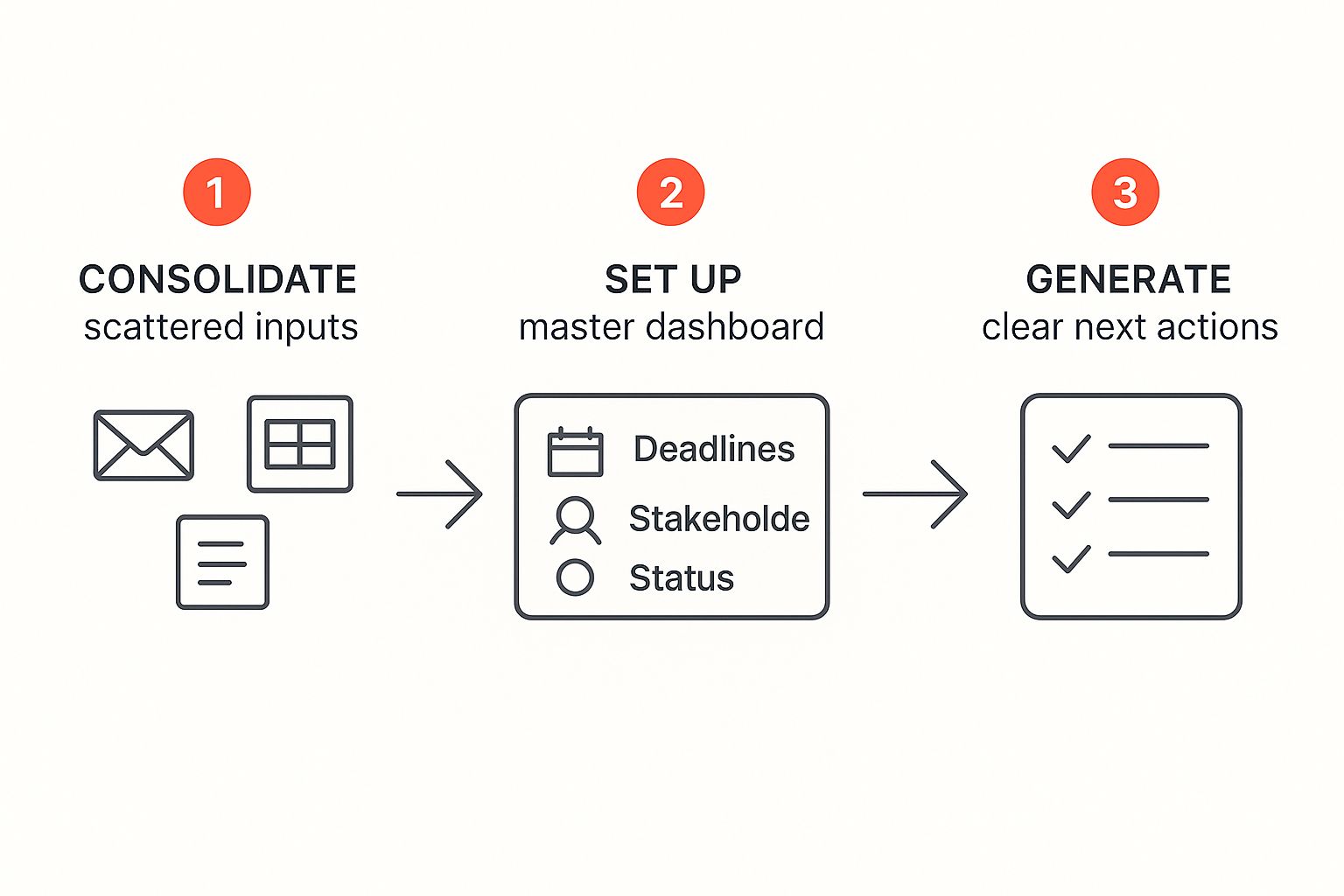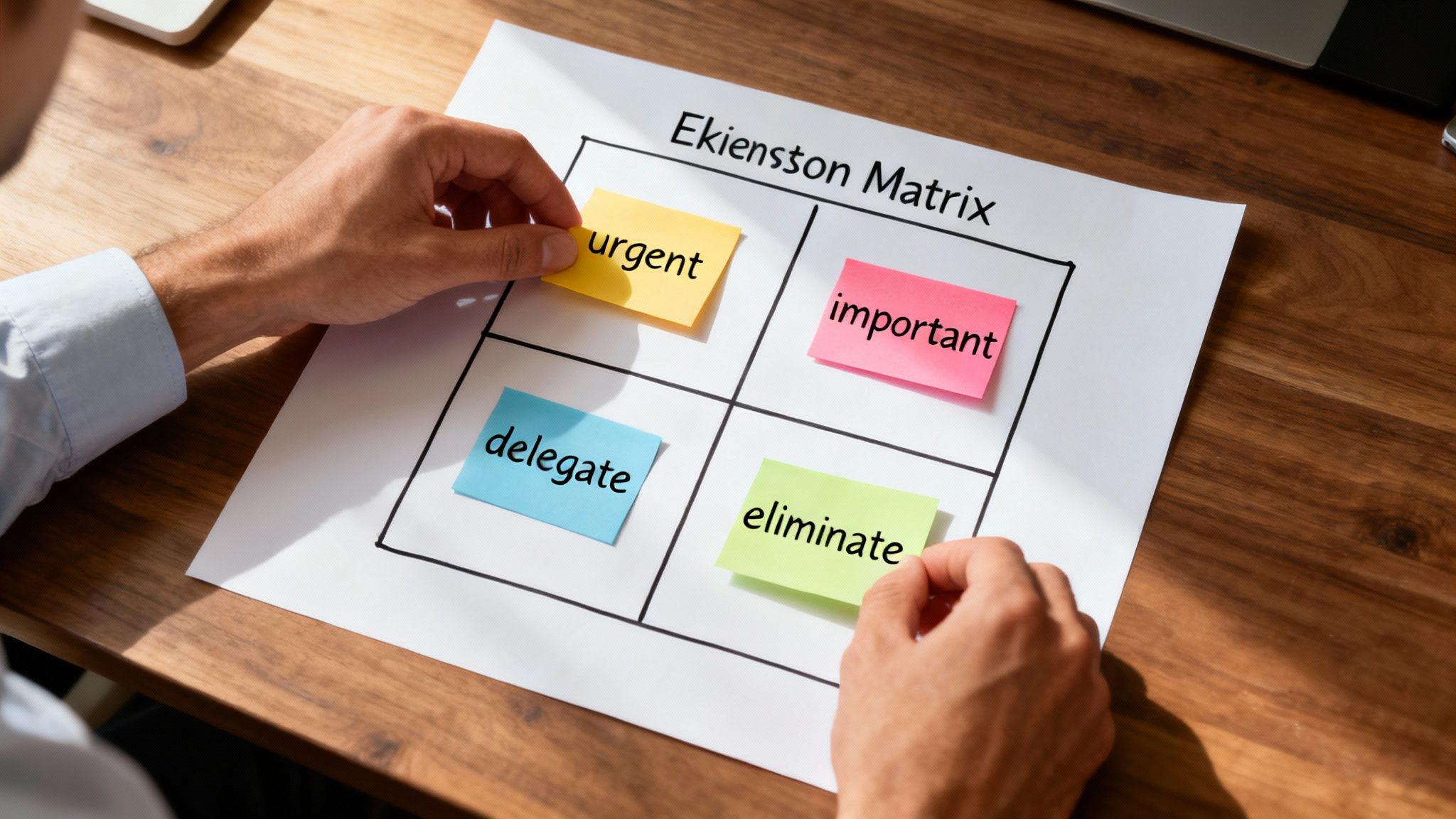How to Manage Multiple Projects Without Burning Out

Learning to juggle multiple projects isn't about working faster or becoming a multitasking ninja. It’s really about building a smart, centralized system to keep everything organized. The real secret is creating a single source of truth for all your work, getting ruthless with your priorities, and using the right tools to handle the grunt work for you. This is how you turn a chaotic to-do list into a clear, manageable plan.
The Modern Reality of Juggling Multiple Projects

Let's be honest, handling just one project at a time feels like a luxury from a bygone era. Today's reality is a constant shuffle between competing deadlines, shifting priorities, and a dizzying amount of context switching. One minute you're putting the final touches on a major client proposal, and the next you're deep in the weeds troubleshooting a technical bug for an internal launch.
Forget the generic advice. This guide gets straight to a proven system for wrestling back control. It’s not about magically finding more hours in the day—it’s about making the hours you have count.
Understanding the Core Challenges
If you've ever felt like you're drowning in work, you're not alone. The struggle is real, and it usually boils down to a few key problems that feed into each other. Pinpointing them is the first step to building a better workflow.
- Scattered Information: Project details are everywhere—buried in emails, scattered across Slack channels, and living in different documents. This makes getting a clear overview next to impossible.
- Competing Priorities: When every single task is labeled "urgent," you lose your ability to focus on the work that actually moves the needle. It's a fast track to burnout.
- The Context-Switching Tax: Jumping between completely different types of tasks drains your mental energy. In fact, research shows this constant switching can eat up as much as 40% of your productive time.
The goal is to build a framework that supports your work, not one that adds another layer of complexity. You need a system that cuts down the mental noise so you can focus on execution, not just organization.
That's exactly what this guide will help you build. We’ll walk through everything from creating a master command center for all your projects to using AI-powered tools like TaskIgnite to automate your workflows. By the end, you'll have an actionable plan to stay on track without feeling completely overwhelmed.
To get started, let's look at the foundational strategies we'll cover. These are the pillars that will support your entire multi-project management system.
Core Pillars of Multi-Project Management
A quick look at the fundamental strategies you'll learn for managing several projects at once.
| Pillar | Core Principle | Key Benefit |
|---|---|---|
| Centralization | Create a single source of truth for all tasks, deadlines, and communication. | Eliminates confusion and provides a clear, real-time overview of everything on your plate. |
| Prioritization | Use a clear framework to determine what needs to be done now versus later. | Ensures you're always working on the most impactful tasks, preventing burnout from "urgent" requests. |
| Delegation | Identify tasks that can be assigned to others to free up your focus for high-value work. | Improves team efficiency and allows you to concentrate on strategic objectives. |
| Automation | Use tools to handle repetitive administrative tasks and streamline workflows. | Saves significant time and reduces the mental load of managing complex project logistics. |
With these core ideas in mind, you're ready to start building a system that actually works for you, not against you. The following sections will provide the specific, actionable steps to make this happen.
Building Your Centralized Command Center
Stop letting critical project details scatter across emails, spreadsheets, and sticky notes. If you want to truly master juggling multiple projects, the first real step is building a single source of truth. Without it, you’re flying blind, and that almost always leads to missed deadlines and a whole lot of unnecessary stress.
Think of this as your mission control. A centralized command center isn't just some fancy to-do list; it's a dynamic dashboard that gives you immediate, high-level clarity. At a glance, you can see who owns what, which deadlines are creeping up, and the real-time status of every single initiative.
Consolidate Everything in One Place
Your first move is to pull all your project information out of the scattered corners where it currently lives. This means digging tasks out of long email chains, migrating data from disconnected spreadsheets, and finally digitizing all those handwritten notes. The goal is to create one unified view of your entire workload.
Getting everything into one system moves you from scattered, messy inputs to a clean, centralized dashboard that actually helps you decide what to do next.

When you consolidate, you stop wasting mental energy just trying to find information. All that brainpower can now be channeled into execution.
The most effective way to do this is with a dedicated tool. In fact, research shows that 77% of high-performing projects use project management software to keep things clear and structured. On average, these platforms can save employees a staggering 498 hours a year just by improving how teams coordinate.
Set Up Your Master Dashboard
Once you've picked your tool, it's time to build your master dashboard. This is the view that should give you an "at-a-glance" understanding of your entire project portfolio.
Let's say you're a marketing consultant juggling three clients: Client A needs a website redesign, Client B has a social media campaign, and Client C is prepping a product launch. You could create a master Kanban board where each client's project is a main column, and individual tasks are cards that move through the stages.
A well-designed command center prevents crucial details from getting lost, cuts down on mental fatigue, and empowers you to make smarter, faster decisions based on a complete picture. It turns reactive firefighting into proactive management.
The key is to configure your dashboard to highlight what matters most to you. It should give you a visual layout that instantly tells you where to focus your attention, so you aren't constantly digging through files and folders.
A good setup should answer these questions in seconds:
- What are my top three priorities today across all projects?
- Which deadlines are at risk?
- Who is the point person for each major deliverable?
Tools like TaskIgnite are built for exactly this purpose, using AI to help create a smart, prioritized view of everything on your plate. By building this centralized system at https://www.taskignite.app, you lay the foundation for every other strategy you'll need to successfully manage multiple projects.
Prioritizing Your Projects and Tasks with Clarity

When every project feels like a top priority, you’re not really making progress. You're just reacting to the loudest fire drill. This is a classic trap that leads to burnout and a lot of frantic, low-impact work.
The real key to how to manage multiple projects is to stop treating your to-do list like a flat, democratic document. You need a system—a framework that helps you make tough calls on what truly matters right now. These frameworks aren't just theory; they're battle-tested tools for cutting through the noise.
Taming Daily Tasks with the Eisenhower Matrix
For sorting through the daily chaos, nothing beats the Eisenhower Matrix. I've used this for years, and its power is in its simplicity. It forces you to look at tasks through two lenses: urgency and importance. Most of us get stuck on "urgent," but it's the "important" stuff that actually moves the needle.
The matrix breaks your workload down into four clear quadrants:
- Urgent & Important (Do First): These are your real fires and hard deadlines. Think a critical bug fix for a client or a proposal that's due this afternoon. No question, these come first.
- Not Urgent & Important (Schedule): This is where strategic wins happen. It's the stuff like long-term planning, process improvement, or mentoring a team member. If you don't intentionally block time for these, they'll never get done—until they become urgent fires themselves.
- Urgent & Not Important (Delegate): These are the interruptions that feel important but don't actually need you. Scheduling meetings, running standard reports, or answering routine info requests are perfect examples. Get them off your plate.
- Not Urgent & Not Important (Delete): Be ruthless here. This is mindless scrolling, meetings without an agenda, and any busywork that adds zero value. Just drop it.
By slotting your daily tasks into these boxes, you immediately see what deserves your full attention versus what's just noise.
Prioritizing Project Milestones with the MoSCoW Method
While Eisenhower is great for your personal task list, the MoSCoW method is my go-to for prioritizing at the project level, especially when stakeholders are involved. It’s a fantastic way to build consensus on what’s truly essential when resources are finite.
MoSCoW is just an acronym that helps categorize features and deliverables:
- Must-Have: These are the absolute, non-negotiable items. If you don't deliver these, the project is a failure. Period.
- Should-Have: These are still very important, but not mission-critical. The project can launch without them, but they add a ton of value.
- Could-Have: These are the "nice-to-have" features. They’re desirable but are the first things on the chopping block when deadlines get tight.
- Won't-Have (This Time): This is just as important as the others. It’s a list of what you've all agreed not to do in this phase, which is your best defense against scope creep.
Let's say you're juggling a new product launch, a major client campaign, and an internal software update. Using MoSCoW, you can clearly define the "Must-Haves" for each. When a key developer gets sick, you know you can push that "Could-Have" reporting feature on the internal tool to protect the "Must-Have" launch date for the new product.
This approach transforms vague priorities into a concrete, shared understanding. It makes those tough conversations about trade-offs a whole lot easier and keeps everyone aligned.
Using AI for Smarter Project Oversight

Let's be honest, AI isn't just some futuristic buzzword anymore. It's become a seriously practical tool for anyone drowning in a heavy workload. When you're trying to figure out how to manage multiple projects, think of AI as a strategic partner—one that handles all the tedious admin work that kills your focus.
Imagine an assistant that drafts those weekly status updates you dread, flags potential budget overruns before they become a real problem, and even finds the perfect time for a stakeholder meeting. That’s what AI does. It takes the low-value, repetitive work off your plate, freeing you up to focus on the big-picture decisions and creative solutions that actually matter.
This is fundamentally changing the game. We're seeing project management tools automate routine tasks, sniff out risks, and even suggest ways to keep things on track. AI can also dig into your past project data to create realistic timelines and cost estimates—a massive help when you’re juggling several projects with different scopes. It's a key part of the top project management trends for 2025 for good reason.
Go Beyond Automation to Predictive Insights
Where AI really shines, though, is in its ability to see what's coming. Modern tools don't just organize your to-do list; they predict future roadblocks. By sifting through data from all your past projects, an AI system can pick up on subtle patterns you'd likely never notice.
For instance, it might spot that projects with a certain vendor consistently run 15% over budget, or that a particular kind of task always takes longer than anyone plans for.
Think of it as a strategic advisor that gives you the insights needed to navigate conflicting timelines before they become crises. It helps you see around corners, turning reactive problem-solving into proactive planning.
This predictive power is invaluable when you're managing a complex portfolio. You can suddenly adjust resource allocation, shift deadlines, and warn stakeholders about potential issues—all with solid data to back you up.
How to Apply AI in Your Workflow
You don't need a technical background to start using AI. Platforms like TaskIgnite have these features built right in, so they're easy for anyone to use. Here are a few practical ways to get started:
- Automated Prioritization: Let an AI engine, like the one in TaskIgnite, chew on your deadlines, dependencies, and project goals to suggest the most critical tasks for the day. It’s a great way to cut through the noise and avoid decision fatigue.
- Risk Assessment: Use an AI-powered dashboard to keep an eye on the health of each project. The system can flag tasks that are falling behind or resources that are stretched too thin, giving you a crucial early warning.
- Smart Scheduling: When you're kicking off a new project, use AI to generate a timeline based on similar work you've done before. This gives you a much more realistic, data-driven forecast right from the start.
By handing off these cognitive burdens to a smart system, you create the mental bandwidth you need to actually lead multiple initiatives instead of just reacting to them. You can find more strategies like this over on the TaskIgnite blog.
Set a Clear Communication Rhythm
When you’re trying to figure out how to manage multiple projects, you quickly learn that managing the work itself is only half the battle. The other half? Managing the endless stream of questions, updates, and stakeholder check-ins. Without a system, communication becomes chaotic, creating confusion and pulling you into a constant cycle of putting out fires.
The answer isn’t more meetings or longer emails. It’s about creating a predictable communication rhythm—a cadence that everyone involved can count on. By setting a clear schedule for updates, you build trust, keep everyone aligned, and, most importantly, you free yourself from the relentless barrage of "what's the status?" pings.
Design a Cadence That Works for You
A one-size-fits-all communication plan is doomed to fail when you have different projects with different stakeholders. What you really need is a layered approach that gives the right level of detail to the right people, without creating a ton of noise.
I've always found it helpful to think in terms of daily, weekly, and monthly touchpoints. Each one serves a very different purpose for a very different audience.
- Daily Check-ins: These are your quick, informal huddles for the core team. Think 15 minutes, tops. The goal isn't deep problem-solving; it's about keeping the momentum going and flagging any immediate blockers.
- Weekly Summaries: This is for your key stakeholders—the people who need to know what's happening but don't need to be in the weeds. A concise email or report covering progress, risks, and what’s next is perfect.
- Monthly Reports: This is the high-level view for leadership, executives, or clients. The focus here is on major milestones, budget updates, and the overall health of your project portfolio.
The real magic here is making communication a predictable, low-effort habit instead of an emergency response. When your stakeholders know a detailed update is coming every Friday afternoon, they're a lot less likely to chase you down on a Tuesday morning.
This rhythm-based system shifts communication from a source of stress to a tool for control. It cements your reputation as an organized and reliable leader, which is absolutely critical when your attention is split across multiple fronts.
Let Automation Do the Heavy Lifting
Establishing these rhythms shouldn't mean adding hours of admin work to your week. The trick is to create simple, repeatable templates and then use your project management tool to automate their delivery. Most platforms today, including our own TaskIgnite, let you build and schedule reports with just a few clicks.
For instance, that weekly stakeholder summary doesn't need to be a masterpiece you craft from scratch every Friday. It can be an automated report that pulls the most important data directly from your project dashboard.
Here’s a simple template you could set up in your tool:
| Section | Content | How to Automate |
|---|---|---|
| Project Health | A simple color code (Green, Yellow, Red) for each key project. | Pulls status directly from project tags or fields. |
| Key Accomplishments | A bulleted list of major tasks completed this week. | Generates from tasks marked "Done" in the last 7 days. |
| Upcoming Priorities | Top 3-5 priorities for the coming week. | Pulls from high-priority tasks with upcoming deadlines. |
| Risks & Blockers | Any issues that need stakeholder attention or decisions. | This is where you add your human touch and analysis. |
By automating 80% of the reporting process, you can focus your limited time on the crucial 20% that actually requires your expertise, like outlining risks and solutions. This small, upfront investment in setting up a communication system pays off big time, giving you back precious hours to focus on what really matters: moving your projects forward.
Answering Your Top Project Management Questions
Even with the best game plan, juggling multiple projects is going to throw some curveballs your way. As you put these ideas into practice, you'll inevitably hit a few common snags. Let's walk through some of the most frequent questions I get asked and give you some straight answers to keep you on track.
From last-minute fire drills to just keeping your own head in the game, these are the real-world challenges that come with the territory.
How Do I Handle Unexpected High-Priority Tasks?
We’ve all been there. You have your day mapped out perfectly, and then—bam—an "urgent" request from a major stakeholder lands in your lap, threatening to blow up your entire schedule. The trick isn't to panic; it's to have a system for dealing with these surprises without letting them derail your whole week.
First things first: don't just take their word for it that it's urgent. Push back a little. Ask some clarifying questions to figure out what's really at stake. Is this new task really more critical than hitting that product launch milestone you're supposed to finish today? Pull out your Eisenhower Matrix and see where it actually fits. You’ll often find that what feels urgent to someone else is really "Urgent but Not Important" for you to handle personally.
If it turns out the task is a genuine, drop-everything priority, you’ve got to make a conscious trade-off.
- Communicate the Domino Effect: Let people know what’s being pushed. A quick message like, "To tackle this new request, I'll need to move the deadline for Project X to tomorrow," prevents nasty surprises down the line.
- Renegotiate Timelines: Don't just hope for the best. Proactively adjust the due dates for the work that has to slide.
- Guard Your Deep Work: Don't let a constant stream of "urgent" tasks shove your important, long-term goals to the back burner forever. Block out time for that strategic work and treat it like an unbreakable appointment with your CEO.
What’s the Best Way to Say No to New Projects?
Learning to say "no" is one of the toughest—but most vital—skills for anyone managing multiple projects. When you’re already stretched thin, piling on more work is a surefire way to see the quality of everything suffer. The most effective way to decline isn't with a vague "I'm busy," but with cold, hard data.
This is where your central project dashboard becomes your best friend. When a new project comes up, you can literally show your current workload, timelines, and where your resources are allocated. You’re not just saying you feel overwhelmed; you’re showing it.
"Saying no isn't about being unhelpful; it's about protecting the quality and deadlines of the commitments you've already made. It shows you're a strategic manager, not just a reactive doer."
Try framing your "no" as a "not right now" and offer some options.
For example: "I'd love to help with that, but as you can see here, my projects have me at 100% capacity through the end of the month. I can either slot this in for the first week of next month, or we could discuss which of my current projects we could de-prioritize to make room." This approach makes it a collaborative decision and reinforces your role as a strategic partner.
How Can I Avoid Burnout When Juggling So Much?
The relentless pressure of managing multiple projects is a fast track to burnout if you aren't deliberate about preventing it. This is where managing your personal energy becomes just as crucial as managing your tasks. One of the biggest culprits is the mental whiplash you get from constantly switching between different projects.
That’s precisely why techniques like time blocking are so powerful. Instead of bouncing between three different projects all day long, you dedicate focused chunks of time to just one. Maybe Monday and Wednesday mornings are sacred "Project A" time, while afternoons are reserved for "Project B."
This simple shift allows your brain to settle in, find its groove, and make meaningful progress. It’s also important to learn how to stay motivated at work by breaking big goals into smaller wins, which gives you that steady drip of accomplishment needed to keep going.
Ready to stop juggling and start managing your projects with clarity and confidence? TaskIgnite uses AI to automatically prioritize your work, predict roadblocks, and create a focused workflow that helps you ship more with less stress. Get your command center set up today at https://www.taskignite.app and turn chaos into control.